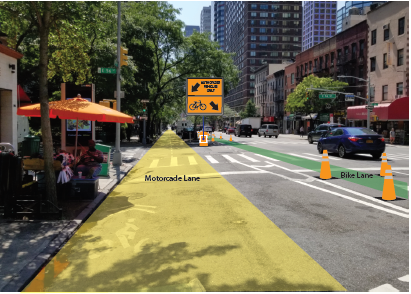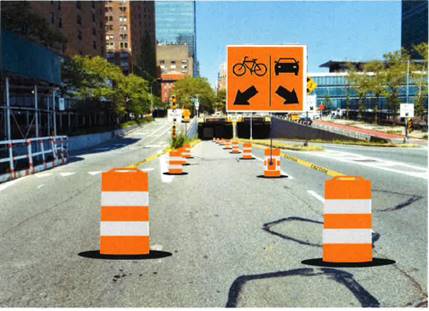The city will create a special lane for cyclists to ride past the United Nations building during the annual General Assembly next week, a change from a longstanding security policy that banned bikes from the area even though car drivers were not similarly restricted.
For years, the city simply would shut the protected bike lanes on First and Second avenues — which carry about 6,000 cyclists daily — during General Assembly week. Last year, Streetsblog reported on the life-threatening conditions forced upon which bikers because of the closures.
Starting on Monday, Sept. 23, the DOT and NYPD will create a protected bike lane that goes through the left tube of the First Avenue tunnel from 40th to 49th streets. Bikers will be separated from moving cars on the left side with orange barrels, signage, and tape. Cyclists will first pass through a security checkpoint at 39th Street before entering the northbound tunnel for nine blocks.
On Second Avenue, the city will use the travel and parking lanes to create a temporary bike lane for cyclists heading downtown between 57th Street and 41st Streets. Like years past, police will use Second Avenue’s existing protected bike lane for emergency vehicles and dignitary motorcades.
This year's strategy is not only about basic rights for cyclists. The Department of Transportation said it is also part of a strategy to get drivers to consider alternative strategies during especially congested periods.
“The U.N. General Assembly sees some of Manhattan’s most congested days of the entire year, and we want to get the word out early to ask drivers to use alternatives,” DOT Commissioner Polly Trottenberg told Streetsblog. “Drivers should leave their cars at home next week if they can — and try walking, taking mass transit, or getting on a bicycle. And we want to thank our partners at NYPD for their creative collaboration this year that will allow safe protected bike lane access along First and Second Avenues.”
Given the outrage from cyclists last year, this year's move was greeted enthusiastically, with advocates noting that it was fitting that the city's leadership was recognizing cycling's importance during the week that global leaders meet to discuss the environment and sustainability. Those issues were dramatized when young Swedish activist Greta Thunberg sailed solo across the Atlantic Ocean for a climate-change summit at the U.N. this month.
"It's great news that the city's General Assembly traffic operation will acknowledge and facilitate East Side bike traffic for the first time. It's an issue we've raised with DOT and PD leadership," said Jon Orcutt of Bike New York. "It would have been sad for the General Assembly to take up sustainable development goals while its limos were blasting bike riders off of established city cycling routes."

DOT says the First Avenue temporary bike lane will be open 24 hours a day during the week-long gathering at the General Assembly, while the temporary Second Avenue Bike lane will close at 9 p.m. Cyclists should also be aware of security checkpoints and unannounced traffic freezes, DOT and NYPD said.
The temporary lanes signal that DOT is no longer putting cars ahead of bikers on two vital pathways. With the summit approaching, cyclists were worried about how they'd navigate the mess again this year. But even before DOT announced its plans, the NYPD quietly broke the news, informing cyclists about the forthcoming temporary bike lanes in a tweet last week.
Bikers were excited.
Thank you @NYPD17Pct for your reply and those arrangements! They would bring real improvements to #bikeNYC in the area compared to last year, especially a dedicated bike lane in the 1st avenue tunnel. I and others are looking forward to it!
— Reasmus (@Reasmus2) September 11, 2019
"Thank you @NYPD17Pct for your reply and those arrangements! They would bring real improvements to #bikeNYC in the area compared to last year, especially a dedicated bike lane in the 1st avenue tunnel. I and others are looking forward to it!" said biker Reasmus2 on Twitter.






